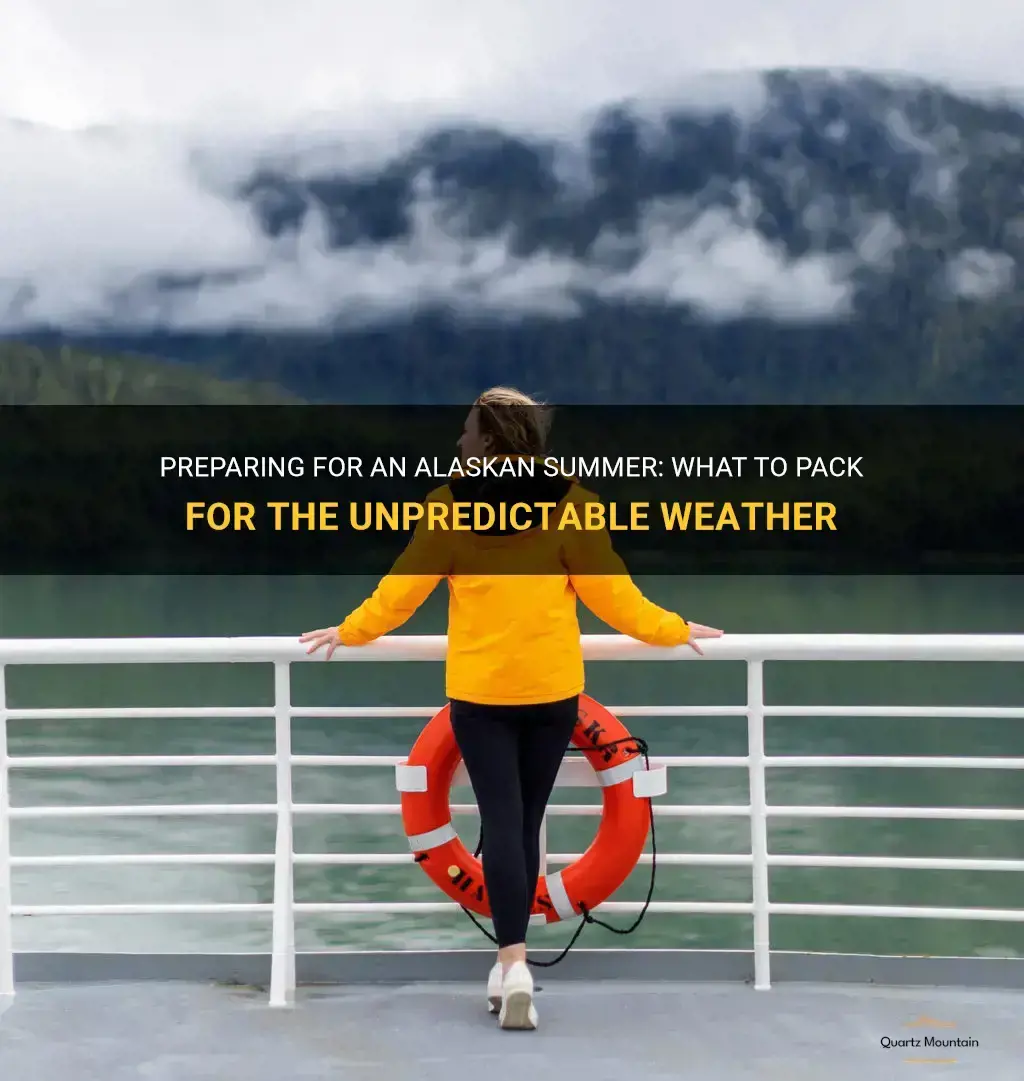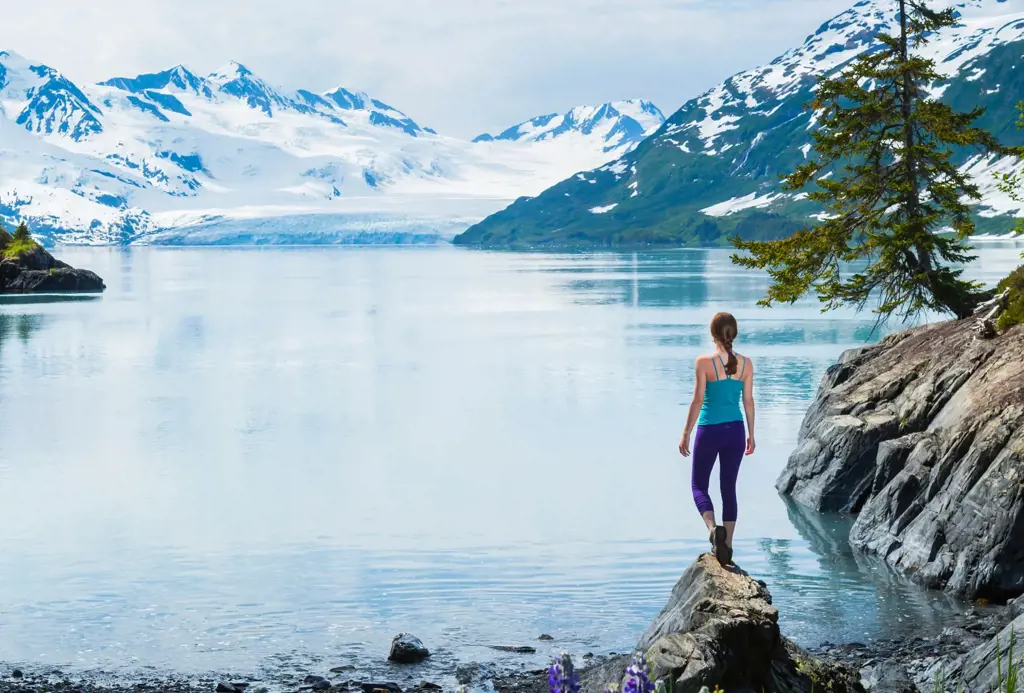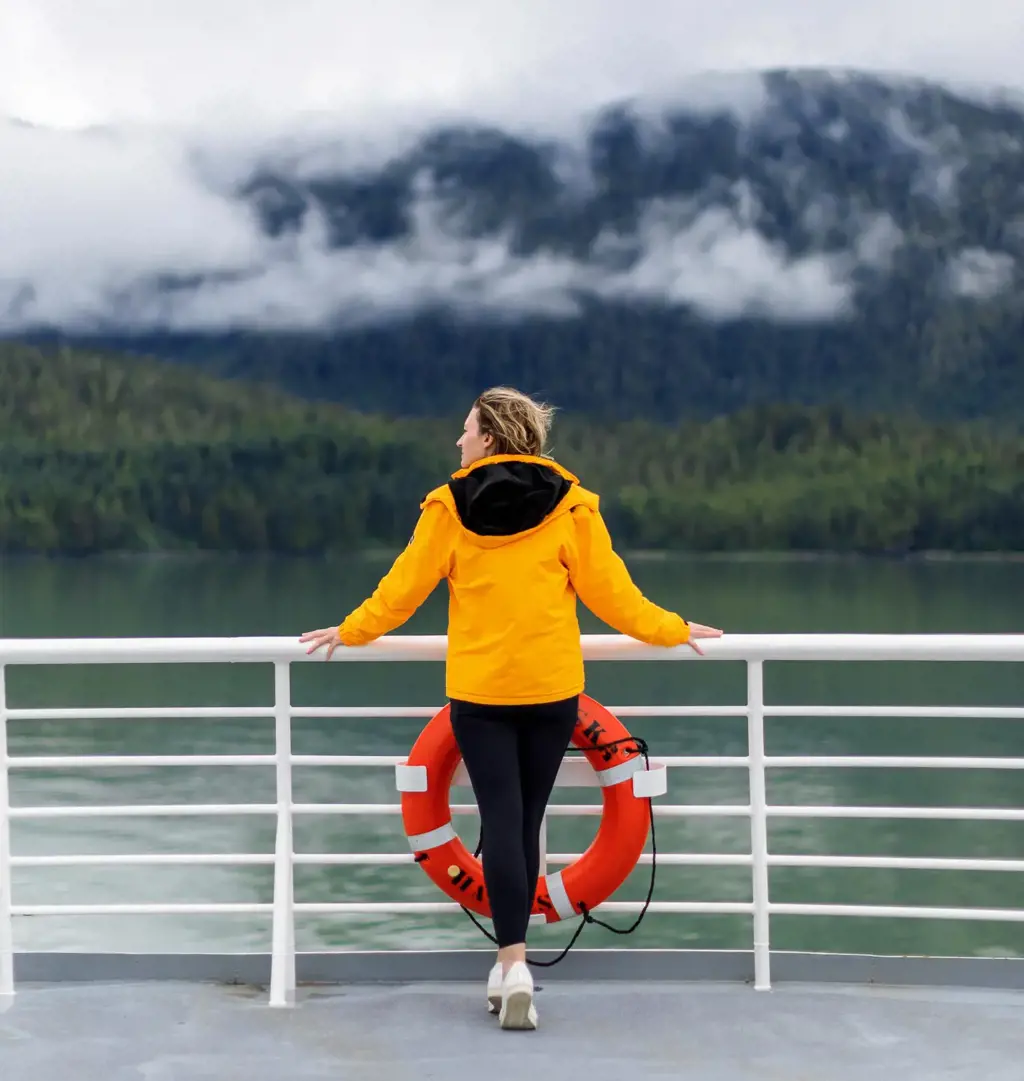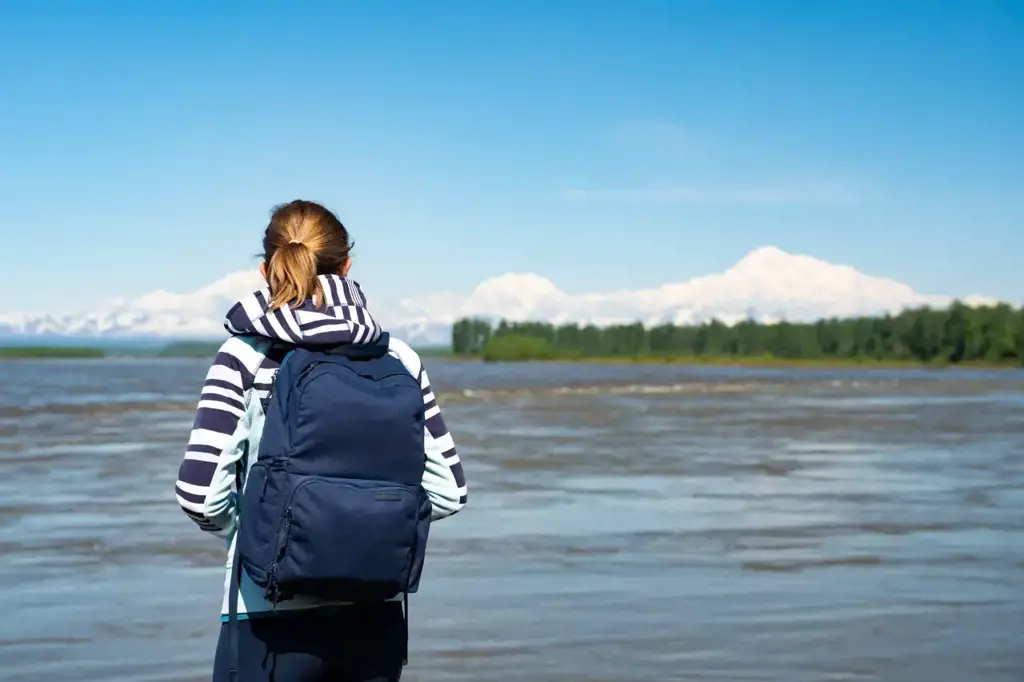
Are you planning a trip to Alaska this summer? Don't forget to pack your layers and prepare for the unpredictable weather! Alaska is known for its stunning natural beauty, but it's also known for its ever-changing climate. One moment, you might be basking in the warm sun, and the next, you could be bundled up in a parka to combat the chilly wind. In this article, we'll explore what essentials you should pack to ensure you're ready for anything that the Alaskan summer weather throws your way. So grab your suitcase and get ready to embark on an adventure of a lifetime in the Last Frontier!
| Characteristics | Values |
|---|---|
| Temperature | 55-75F |
| Rainfall | 1-2in |
| Daylight | 18+hrs |
| Mosquitoes | High |
| Pack | Layers |
| Raincoat | |
| Bug repellent | |
| Hiking boots |
What You'll Learn
- What is the average temperature in Alaska during the summer months?
- What are some essential items to pack for the unpredictable Alaskan weather in the summer?
- How does the weather in Alaska during the summer compare to other seasons?
- Are there any specific clothing items or gear needed for outdoor activities in Alaska during the summer?
- Are there any unique considerations for packing for an Alaskan summer trip, such as insect repellent or bear safety gear?

What is the average temperature in Alaska during the summer months?

Alaska, known for its stunning landscapes and extreme weather conditions, experiences a unique climate during the summer months. Due to its location in the northernmost part of the United States, Alaska's summer temperatures differ significantly from those in other parts of the country. In this article, we will explore what the average temperature in Alaska is during the summer season, and delve into the factors that contribute to these temperatures.
The average summer temperature in Alaska varies depending on the region. The coastal areas, such as Anchorage and Juneau, tend to have milder temperatures compared to the more inland regions. On average, coastal areas experience temperatures ranging from the mid-50s to the mid-70s Fahrenheit (13-24 degrees Celsius) during the summer months. However, it is important to note that Alaska's weather can be quite unpredictable, and there may be occasional heatwaves or cold snaps that deviate from the average temperatures.
Inland regions, such as Fairbanks and Denali National Park, often have warmer summers compared to the coastal areas. The average temperature in these regions ranges from the mid-60s to the mid-80s Fahrenheit (18-29 degrees Celsius). It is not uncommon for temperatures to occasionally reach the 90s Fahrenheit (32-35 degrees Celsius) in some areas, especially during heatwaves.
Several factors contribute to Alaska's summer temperatures. Firstly, Alaska's high latitude plays a significant role. Due to its proximity to the Arctic Circle, Alaska experiences long daylight hours during the summer, known as the Midnight Sun. This extended exposure to sunlight results in increased heating of the atmosphere and contributes to higher temperatures. Additionally, the presence of the Pacific Ocean affects the coastal regions, moderating the temperatures and creating a maritime climate.
Another influencing factor is Alaska's vast and varied topography. The mountains and glaciers in the interior can significantly impact local weather patterns, causing variations in temperature. For instance, areas near glaciers may experience cooler temperatures due to the cold air flowing from the ice. Similarly, valleys and higher elevations can create temperature inversions, leading to variations in local climate.
It is worth mentioning that Alaska's summer temperatures are also influenced by climate change. Over the past few decades, Alaska has been experiencing a rise in average temperatures, leading to changes in ecosystems and the melting of glaciers. These changes have diverse impacts on local flora, fauna, and human activities.
To illustrate further, let's consider an example. In Denali National Park, located in interior Alaska, the average summer temperature is around 60-70 degrees Fahrenheit (15-21 degrees Celsius). However, during heatwaves, the temperature can spike up to the 80s or 90s Fahrenheit (27-35 degrees Celsius). This dramatic temperature shift can influence the behavior of wildlife and impact visitor activities.
In conclusion, the average summer temperature in Alaska varies depending on the region, with coastal areas experiencing milder temperatures compared to the inland regions. Factors such as high latitude, proximity to the Arctic Circle, topography, and the presence of the Pacific Ocean contribute to these temperatures. However, it is important to keep in mind that Alaska's weather is known for its unpredictability, and occasional heatwaves or cold snaps can deviate from the average temperatures. By understanding these climate dynamics, visitors and residents can better prepare and appreciate the unique summer experience Alaska has to offer.
Essential Items to Include in Your Turks and Caicos Packing List
You may want to see also

What are some essential items to pack for the unpredictable Alaskan weather in the summer?

As the largest state in the United States, Alaska is renowned for its stunning natural landscapes, including its epic mountains, dense forests, and vast glaciers. However, one aspect of Alaskan weather that often surprises visitors is its unpredictability, even in the summer months. Whether you're exploring the pristine wilderness or enjoying the vibrant city life in Anchorage or Fairbanks, it's essential to pack the right items to ensure your comfort and safety. Here are some key items that you should consider when packing for the unpredictable Alaskan weather in the summer.
- Layered Clothing: Alaskan summers can bring a wide range of temperatures, from chilly mornings to mild afternoons and cooler evenings. It's crucial to pack a variety of clothing options that can be layered to suit different weather conditions. Start with a base layer of moisture-wicking and insulating materials, such as merino wool or synthetic blends. Add mid-layers for insulation, such as fleece or down jackets, and top it off with a waterproof and wind-resistant outer layer. This layering system allows you to adapt to changing weather conditions and remain comfortable throughout the day.
- Waterproof Gear: Alaska is known for its precipitation, even in the summer months. Be prepared for rain by bringing waterproof gear, including a reliable rain jacket, waterproof pants, and waterproof footwear. Look for gear with taped seams and adjustable features to ensure maximum protection against the elements. Don't forget to pack a waterproof cover for your backpack or a dry bag to protect your valuables from getting wet.
- Sturdy Footwear: With its rugged terrain and potential for wet conditions, having appropriate footwear is vital in Alaska. Opt for sturdy hiking boots or trail shoes with good traction and ankle support. Waterproof or water-resistant footwear is ideal, but if you don't have access to such gear, consider packing an extra pair of lightweight shoes or sandals for leisurely activities.
- Insect Repellent: Alaska is home to abundant wildlife, including mosquitoes and other biting insects. To enjoy the outdoors without being bothered, pack a quality insect repellent that contains DEET or another effective active ingredient. Don't forget to apply it to exposed skin before heading out, especially during dawn and dusk when insects are most active.
- Sun Protection: While you may not associate Alaska with sunny weather, the summer months can bring long days with prolonged sun exposure. Bring sun-protective clothing, including hats, sunglasses, and lightweight, long-sleeved shirts. Don't forget to pack sunscreen with a high SPF to protect your exposed skin from harmful UV rays.
- Binoculars and Camera: Alaska is a photographer's dream, with its breathtaking scenery and diverse wildlife. Don't miss out on capturing those incredible moments – pack a pair of binoculars and a camera to enhance your experience. Whether you're capturing the majestic flight of an eagle or observing bears fishing for salmon, having the right equipment will ensure you can document these unforgettable moments.
Remember, the key to surviving and enjoying the unpredictable Alaskan summer weather is preparation. By packing these essential items, you'll be well-equipped to handle the fluctuations in temperature, rain showers, and potential encounters with wildlife. Don't let the weather deter you from experiencing the beauty and adventure that Alaska has to offer – embrace the elements and make lasting memories.
The Essential Guide: Top Items to Avoid Packing When Flying
You may want to see also

How does the weather in Alaska during the summer compare to other seasons?

Alaska is known for its extreme weather conditions, with long, cold winters and short, cool summers. However, during the summer months, the weather in Alaska changes dramatically compared to other seasons.
In Alaska, summer is a time of transformation. The long days and abundant sunlight create an explosion of growth and life. The once frozen landscapes come alive with vibrant greenery, blooming flowers, and bustling wildlife.
One of the most noticeable differences in the summer weather is the temperature. While winter temperatures in Alaska can plummet to -40 degrees Fahrenheit, summer temperatures typically range from 60 to 80 degrees Fahrenheit. This significant increase in temperature allows for more outdoor activities and exploration.
The extended daylight hours also play a crucial role in Alaska's summer weather. During the summer solstice, which occurs around June 21st, the sun can be visible for almost 24 hours a day. This phenomenon, known as the midnight sun, gives Alaskans the unique experience of enjoying an endless summer day. The prolonged sunlight provides ample opportunities for outdoor recreational activities, such as hiking, fishing, and camping.
Another noteworthy aspect of Alaska's summer weather is the relatively low amount of precipitation. Compared to the rain and snowfall experienced throughout the rest of the year, summer in Alaska is known for its clear, sunny skies. This favorable weather condition further enhances the outdoor experience and allows visitors and residents to soak in the stunning natural scenery without the hindrance of inclement weather.
However, it's important to note that Alaska's weather can still be unpredictable, even during the summer months. Rain showers and thunderstorms can occur unexpectedly, especially in coastal areas. It is advisable for visitors to come prepared with appropriate clothing and gear to handle sudden changes in weather conditions.
To fully understand the variability of Alaska's summer weather, let's consider an example. Imagine you are visiting Alaska in July, a prime summer month. You start your day under clear blue skies with a temperature of 75 degrees Fahrenheit. As you venture out for a hike, you may encounter occasional rain showers that last for a short duration. Despite the rain, the temperature remains mild, and the sun quickly reemerges. The hike concludes with breathtaking views of glaciers and wildlife, all illuminated by the radiant summer sunlight.
In conclusion, the weather in Alaska during the summer season differs significantly from other times of the year. The temperature rises, the daylight hours increase, and precipitation reduces, creating ideal conditions for outdoor activities and exploration. While weather can still be unpredictable, visitors can expect a unique and memorable experience in Alaska's summer landscape.
Essential Items to Pack for a Successful Detox Journey
You may want to see also

Are there any specific clothing items or gear needed for outdoor activities in Alaska during the summer?

Alaska is a beautiful state with vast outdoor recreational opportunities. From hiking and fishing to kayaking and wildlife spotting, there's something for everyone. However, the weather in Alaska can be unpredictable even during the summer months. It's important to be prepared with the right clothing and gear to ensure a safe and comfortable outdoor experience.
Layering is key:
Due to the fluctuating temperatures, layering is crucial in Alaska. Start with a moisture-wicking base layer to keep sweat away from your skin. Merino wool is an excellent choice as it is breathable and odor-resistant. Top it off with a mid-layer for insulation, such as a fleece or down jacket. Finally, add a waterproof and windproof shell as your outer layer to protect against rain, wind, and unexpected temperature drops.
Footwear:
Investing in a good pair of waterproof hiking boots is essential for outdoor activities in Alaska. Look for boots with sturdy soles, ankle support, and a waterproof membrane to keep your feet dry in wet conditions. Additionally, pack a pair of lightweight and quick-drying water shoes for activities like kayaking or fishing.
Hats and gloves:
Don't forget to protect your extremities from the sun and cold. A wide-brimmed hat will shield your face and neck from the sun's rays, while a pair of lightweight gloves will keep your fingers warm during chilly mornings or cold winds. Consider bringing a lightweight beanie as well for added warmth during colder evenings or at higher altitudes.
Sunglasses and sunscreen:
The sun's rays can be intense in Alaska, especially during the summer months when the days are longer. Invest in a good pair of sunglasses with UV protection to shield your eyes from harmful rays. Additionally, apply sunscreen with a high SPF to protect your skin from sunburn, even on cloudy days.
Insect repellent:
Alaska is known for its mosquitoes and other biting insects. Be prepared by packing a reliable insect repellent containing DEET or another effective ingredient. Consider long-sleeved shirts and pants as an additional layer of protection against bites.
Bear safety equipment:
If you plan on hiking or camping in bear country, it's essential to carry bear safety equipment. This may include bear spray, a loud whistle, or bear bells to alert bears of your presence. Make sure you know how to use these items properly and follow all bear safety guidelines.
Outdoor gear:
Depending on the specific activities you plan to engage in, you may need additional gear. For hiking, consider a comfortable and sturdy backpack to carry essentials like water, snacks, and extra layers. For fishing, pack a fishing rod, tackle box, and appropriate clothing like chest waders. Always research and pack the necessary gear for your chosen outdoor activities.
In conclusion, Alaska offers a myriad of outdoor activities during the summer months. Being properly prepared with the right clothing and gear is essential for a safe and enjoyable experience. Layering, waterproof footwear, hats, gloves, sunglasses, sunscreen, insect repellent, bear safety equipment, and any specific gear for your chosen activity are all important items to consider. Remember to research the weather conditions and terrain you will be facing and plan accordingly. Stay safe and have a fantastic time exploring the great outdoors in Alaska!
The Essential Items to Pack for a Trip to Miami: A Comprehensive Guide
You may want to see also

Are there any unique considerations for packing for an Alaskan summer trip, such as insect repellent or bear safety gear?

When packing for an Alaskan summer trip, there are indeed some unique considerations that should be taken into account. The rugged wilderness and unique wildlife of this state make it important to come prepared with the right gear and supplies. Here are some key items to pack for your Alaskan adventure.
- Insect repellent: Mosquitoes and other biting insects can be quite prevalent in certain areas of Alaska during the summer months. It is advisable to bring along a good quality insect repellent to protect yourself from their bites. Look for a repellent that contains DEET or other effective mosquito-repelling ingredients.
- Bear safety gear: Alaska is home to various species of bears, including grizzly bears and black bears. While bear encounters are relatively rare, it is still crucial to be prepared. Consider packing bear deterrents such as bear spray, which can be purchased from outdoor stores. Additionally, bear bells can be attached to your backpack or clothing to create noise as you hike, alerting any bears of your presence and reducing the chances of surprising them.
- Waterproof clothing and shoes: Alaska's weather can be unpredictable, and rain showers are not uncommon, even in summer. Being prepared with waterproof or water-resistant clothing, including a rain jacket and pants, will help keep you dry and comfortable during your outdoor activities. Additionally, waterproof or water-resistant footwear, such as hiking boots, will keep your feet dry and provide better traction on wet terrain.
- Layered clothing: Even during the summer months, temperatures in Alaska can vary greatly throughout the day. It is advisable to bring along layered clothing to adjust to the changing weather conditions. This way, you can add or remove layers as needed to stay comfortable. Include items such as long-sleeve shirts, lightweight sweaters or fleeces, and a warm jacket or coat.
- Sun protection: Despite the cooler temperatures, the sun can be intense in Alaska, especially during long daylight hours. It is crucial to protect your skin from sunburn and UV damage. Pack a broad-spectrum sunscreen with a high SPF and apply it regularly, especially to exposed areas. Don't forget to bring along a wide-brimmed hat and sunglasses to protect your face and eyes from the sun's rays.
- Binoculars and camera: Alaska is known for its stunning landscapes and diverse wildlife. Don't forget to pack binoculars and a camera to fully appreciate and capture the beauty of the state. From spotting distant wildlife to capturing the breathtaking scenery, these items will enhance your experience and allow you to take home lasting memories.
- First aid kit: When venturing into the Alaskan wilderness, having a basic first aid kit can be essential. Include items such as adhesive bandages, antiseptic ointment, pain relievers, and any personal medications you may require. It is also a good idea to have a booklet or guide on wilderness first aid, just in case.
Remember, the key to a successful Alaskan summer trip is preparation and being aware of your surroundings. While it is essential to pack the right gear and supplies, it is equally important to research and educate yourself about the area you will be visiting. Familiarize yourself with wildlife safety guidelines and proper hiking etiquette, and always be respectful of the environment. With proper preparation and a sense of adventure, your Alaskan summer trip is sure to be an unforgettable experience.
Essential Items to Include in Your Packing List for Colorado in September
You may want to see also
Frequently asked questions
The weather in Alaska during the summer months is generally mild and can vary greatly depending on which part of the state you are in. In general, temperatures range from 50°F to 70°F (10°C to 21°C), but it can get cooler or warmer depending on the day. It is also important to note that while the days are longer in Alaska during the summer, the weather can still be unpredictable, so it is best to come prepared for a variety of conditions.
When packing for a trip to Alaska during the summer, it is important to be prepared for a wide range of weather conditions. You should pack layers, including long-sleeved shirts, sweaters or jackets for cooler days, and lighter clothing for warmer days. It is also a good idea to bring a waterproof jacket or raincoat, as well as sturdy walking shoes or hiking boots for outdoor activities. Don't forget to pack sunscreen, a hat, and sunglasses to protect yourself from the strong sunlight, as the days can be long in Alaska during the summer.
Mosquitoes can be a nuisance in Alaska during the summer months, especially in areas with standing water or dense vegetation. It is a good idea to pack insect repellent and long-sleeved shirts and pants to protect yourself from mosquito bites. Additionally, some travelers find it helpful to bring a mosquito net for added protection, especially if they plan on camping or spending a lot of time outdoors.
While the Northern Lights are typically associated with colder months, it is still possible to see them in Alaska during the summer. However, the chances of seeing the Northern Lights are lower during this time of year due to the increased daylight hours and the fact that the sky needs to be dark to see the lights. If you are specifically hoping to see the Northern Lights, it may be best to plan your trip for the fall or winter months when the nights are longer and darker.







